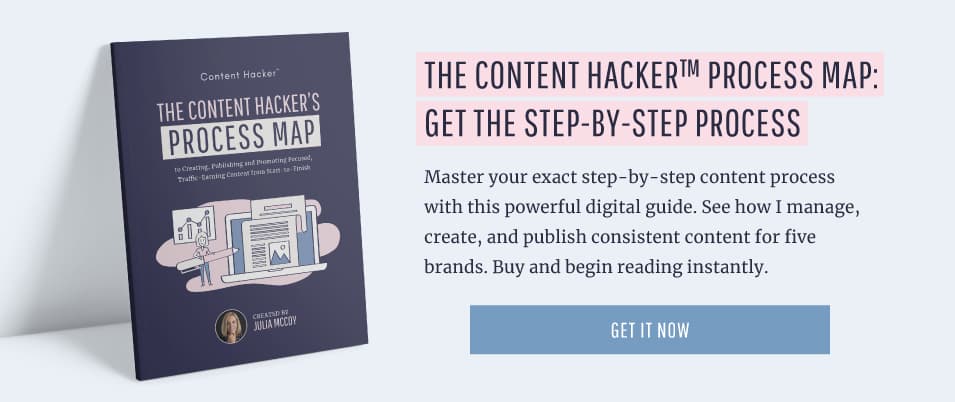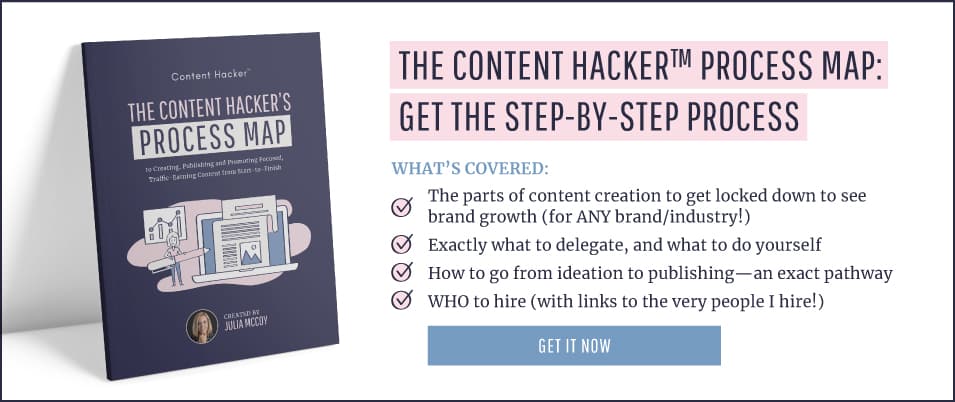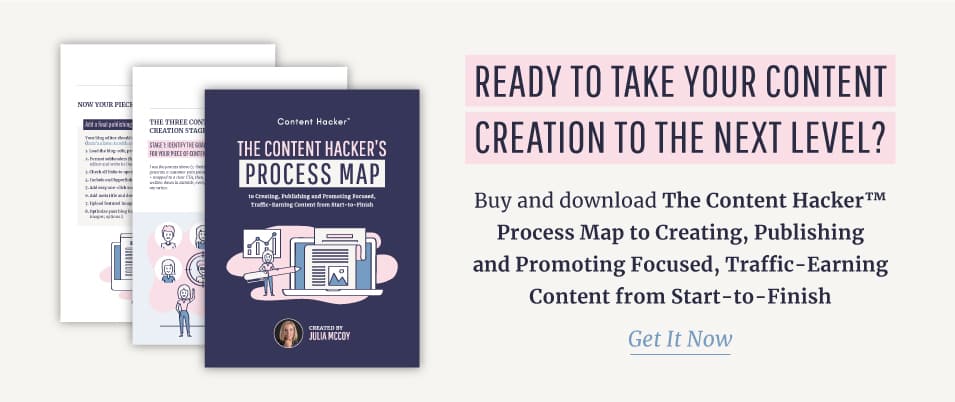Quick question… What if you never had to guess again when it comes to content marketing ideas that bring MASSIVE return?
What if you knew exactly what to write the moment you sat down to create and schedule your content marketing?
We all dream of it:
- Never running out of content marketing ideas
- Pulling in massive ROI from each piece of content we publish
- Having a never-ending stream of topics our audience craves and devours
- Never having to panic with no idea what to write about
- Getting a steady stream of site traffic from the share-worthy blogs we publish
And achieving all this:
- Without working 15 hours a day
- Without having to brainstorm until you feel brain-dead
- Without worrying about burning out
- And best of all, knowing you can actually predict content marketing results
I know, it sounds like a miracle.
The stuff of dreams.
But it’s not.
Because in my near-decade of experience in content marketing, I’ve created a process that makes it not only possible, but also easy and fun.
Almost a no-brainer, really, once you settle into it.
The good news is I’ve put this mega guide together to show you my exact system as a content hacker. It’s the system I use to create content for all my five brands.
In this guide, I’ll show you:
- How to get from stressed, over-worked content creator who pulls in meagre results at best…
- …to relaxed, profitable content hacker who never burns out or runs out of ideas.
- How I get so much done
- How I went from zero to hero in content marketing
- Ways to come up with a never-ending stream of content marketing ideas
- The top tools I use for content creation
- And more!
Ready to make the transformation?
Let’s get into today’s topic.
How to Level Up Your Content Marketing Ideas and Profits: Table of Contents
1. First: Come Up with a Content Strategy
2. How the Right Content Strategy Turned the Tide for My Content Agency, Express Writers
3. Six Steps to a Content Strategy that Works
4. Use the 3-Bucket Topic Strategy to Come Up with Profitable Content Marketing Ideas
5. Come Up with Content Marketing Ideas Using a Seed Keyword
6. Use Keyword Research and Long-Tail Keywords to Come Up with Brilliant Content Marketing Ideas
7. Repurpose What’s Working for Other Content Marketers
8. Use Social Media to Dig Out Content Marketing Ideas Your Audience Loves
How to Be a Powerful Content Marketer without Burning Out
1. Stick to a Schedule
2. Switch to Managing Instead of Doing
3. Keep These Tools Under Your Arm as You Plan and Create Content

The Secret Sauce for Leveling Up Your Content Marketing Ideas and Profits and Becoming a Content Hacker
Facts, fam. I didn’t start out as a profitable content hacker.
In fact, till about 2016, I was falling on my face again, and again. Creating countless content pieces that went nowhere. Seeing my business fall flat in revenue for months.
But nine years of trial-and-error, learning the hard way, experience, and a bunch of successes and failures helped me structure a fail-proof system that works every time.
Here’s that exact system.
1. First: Come Up with a Content Strategy
Simply put, it’s the blueprint behind every piece of content you create.
Think of it as the map of your content marketing journey. Each blog, email, social media post, and webpage you create fits into this map and guides your content in the direction of your goals.
Coming up with a workable content strategy is key to turning your lackluster content marketing efforts into success.
Don’t believe me? Here’s my story to prove it.
2. How the Right Content Strategy Turned the Tide for My Content Agency, Express Writers
I founded my content agency Express Writers with a single goal, and that was to sell the company on what I sold. That is, excellent, top-notch content without pushy, annoying sales tactics.
And it worked. In 2015:
- I had published 215 blogs with 141 keywords ranking.
- We were earning around 29K a month in gross income.
- Our site visitors peaked at 500 a day.
Was it good enough?
Not quite. In fact, it was far from the success I’d dreamed of.
Plus, I was burnt out and overworked. Stressed. Pouring tons of energy into the wrong places.
What was I doing wrong?
I didn’t have a content strategy. It’s that simple.
In 2016, I decided to make a change. I fired the managers who were embezzling from me. I put my newly-hashed content strategy in place. And I sat back to watch the stunning results explode.
- A few months after implementing my content strategy, we hit our first 71K in gross earnings for a single month.
- The number of keywords we ranked for on Google DOUBLED.
And we haven’t stopped since then.
- We now have 100,000 site visitors a month.
- We have 19,000 keywords indexed on Google (gained organically! This would have cost over $200,000 in paid ads).
- We’re the 25,700th most popular site on Google.
All this magic happened because of my content strategy.
To enjoy my success, you need to come up with your own.
Follow these six steps to get there.
3. Six Steps to a Content Strategy that Works
According to Content Marketing Institute, content strategy helps you manage all your content. With a workable strategy in place, you’ll never guess again when creating content for your brand.
Follow these steps to come up with your content strategy.
Step 1: Learn the Basics of Content Strategy
Content strategy has a ton of different aspects you need to dive into and understand.
- It’s intrinsically linked with content marketing.
- It connects all your business goals.
- It drives every single piece of content you create.
- It involves the entire lifecycle of content.
You can learn content strategy yourself through free resources online. But if you want to fast forward your journey and become an expert in only six weeks, you can take the Content Strategy and Marketing Course. In this course, I turn content strategy inside-out with actionable guides, templates, examples, advice, and more.
Or read my book, Practical Content Strategy and Marketing. Learn the how, where, and why of content. Plus, get proven strategies on how to get your content in front of your audience.
Step 2: Define Your Audience and Learn how to Turn them into Customers
The first step is knowing exactly who your audience is, including their paint points, dreams, and desires. Create marketing personas so your content speaks personally to them each time you sit down to write.
Then, learn how to turn this audience into customers. Since your brand and audience are unique, you’ll need a strategy that matches both.
Step 3: Integrate SEO into Your Content
70% of all traffic starts with search. If you want to get attention online, your site needs to rank highly on Google.
The best way to do it is through creating SEO-optimized content.
I don’t mean keyword stuffing. I mean:
- Valuable content created around your audience’s pain points
- Well-researched keywords planted in the crucial parts of your content
- Content optimized for both robots AND humans
Read my blog on what to do if your site is dead on Google’s rankings and how to fix it.
Step 4: Create a Profitable Content House on Your Own Turf
Work hard to build an awesome content house on your own turf (your own site).
This is what it should look like.

Sure, you can guest blog and post content on social media. But your #1 focus should be on your own site.
In fact, you can think of social media, guest blogging, and solo guest appearances as roads that lead to your own awesome content house.

Step 5: Create Strategically
Set up a workflow for creation and publication. Let your content strategy guide each piece of content you create. And remember, focus on quality instead of quantity.
Step 6: Invest in Maintaining Your Content Boat
It’s not enough to create content and click publish. You need to invest in maintenance if you want to keep your content boat afloat.
Do these three things:
- Set a budget for quality content. Don’t go cheap on the most important part of your content marketing.
- Run an audit on your old posts. Are there any outdated pieces? Poor content you published in the past? Take time to update or improve them.
- Continuously “air out” or promote your content. You want to make sure no one misses the high value you’re giving.
4. Use the 3-Bucket Topic Strategy to Come Up with Profitable Content Marketing Ideas
How can you be sure each piece of content you create is profitable?
It’s important to ask yourself this because you don’t want to waste time creating random, worthless pieces.
To avoid this problem, I came up with the 3-bucket topic strategy.
Here’s how it works.
Each time I create content, I make sure it fits into one of three topic buckets.

- Bucket #1: SEO-optimized content. The goal of content in this bucket is to improve my site’s Google ranking.
- Bucket #2: Content in this bucket is built around converting my audience into buying customers.
- Bucket #3: A bucket full of “viral” and “fun” content. Its purpose is to entertain and help develop a stronger relationship with my audience.
If you’re creating a brilliant piece of content and it doesn’t fit into any of these buckets, scrap it immediately!
5. Come Up with Content Marketing Ideas Using a Seed Keyword
A seed keyword is a foundation keyword for SEO. You use it to build your long-tail keywords and come up with exciting content marketing ideas.
Using a seed keyword, you can come up with tons of topic ideas for your content.
Here are two great ways to do it.
1. Use Google Suggestions
Let’s imagine you own an online store selling women’s clothing. To start, pick a seed keyword such as “dresses.”
Go to Google and type this seed keyword into the search bar. What you’ll get is a list of suggestions based on searches done by real people.

This gives you an idea of what your audience is interested in and what they’d like to see in your content.
2. Use Keywordtool.io
Visit the site and type your seed keyword in the search bar. You’ll get tons of suggestions, including information on search volume and competition.
The keyword “dresses” pulled in 553 unique results!

6. Use Keyword Research and Long-Tail Keywords to Come Up with Brilliant Content Marketing Ideas
One of my favorite keyword research tools is KWFinder. I use it mainly for keyword research, but it also helps me brainstorm profitable topics my audience will love.
To start, I type my seed keyword in the search bar.
Let’s say I typed “dresses” in. The results look like this.

The next step is to pick keywords that hit the sweet spot between high search volume and low keyword difficulty.
- If you own a new site, pick keywords with a difficulty level lower than 40.
- If you own an established site, you can go for a difficulty level anywhere below 70.
Found your keyword? That’s it! Let’s say you chose “party dresses.” A search volume of 285,000 and keyword difficulty of 36 is a great place to start.
Take your keyword and brainstorm 5-10 blog topics around it. Write them down.
- How to Wear Party Dresses Like a Boss
- 15 Ways to Pick a Party Dress on a Budget
- The Number One Way to Create Your Own Glorious Party Dress without Breaking the Bank
- 10 Things to Look for when Buying Party Dresses
- How Celebrities Pick Party Dresses
After you’ve written 5-10 ideas around your keyword, move on to the next keyword and come up with 5-10 ideas for that one. Keep writing those ideas down even if they don’t seem spectacular at first. You can easily tweak and improve them later.
If you’re feeling stuck, I recommend using HubSpot’s Blog Ideas Generator. Simply type your keyword into the search box, and you’ll get blog topic suggestions to match it.
Here’s what I got for my search on “party dresses.”
- Party Dresses: Expectation vs. Reality
- Will Party Dresses ever Rule the World?
- The Next Big Thing in Party Dresses
- Party Dresses Explained in Fewer than 140 Characters
- This Week’s Top Stories about Party Dresses
7. Repurpose What’s Working for Other Content Marketers
Disclaimer: I don’t mean we should steal ideas from other content marketers. That’s against copyright laws, plus your audience won’t appreciate it.
I also don’t mean we should simply “spin” great content by stealing its flow and merely changing the words to escape copyright laws.
What I mean is to use top-shared content to:
- Inspire you
- Spark up your creativity
- Learn what your audience loves
To start, open your favorite content discovery tool. My personal go-to tool is BuzzSumo.
Read my ultimate guide on how to use BuzzSumo to discover hot topics here.
On BuzzSumo, go to the Content option and select Web Content Analyzer.

Type your keyword in the search bar.
What you’ll get is a list of the top engaged-with content for your keyword.
For instance, “party dresses.”

Notice the #1 top-shared piece?
“Women Are Throwing ‘Wedding Dress Parties’ For An Excuse To Wear Their Dresses Again.” It has 66.8K total engagement, which means your audience loved it!
Inspiring much?
The next step is to scrutinize the top-shared piece and find out why readers loved it.
Here’s what the piece looks like. (Visit it here to check it out yourself.)

Here are five things I noticed about it:
- It’s easy to read.
- Paragraphs are limited to one to two lines.
- It’s loaded with social media photos from real people.
- It features beautiful dresses and girls having the time of their lives partying without the guys.
- It’s light, fun, and full of hilarious memes.
Now you have an idea of the kind of content, style, and voice your audience loves!
Now, work to put together something just like it but at the same time all your own.
Ask yourself these questions to come up with ideas:
- If the post is outdated, is there any way you can update it with new research?
- Do you agree or disagree with the opinions in the post?
- Is there an angle that the post ignores?
- Can you make the post better? Is there anything missing in it that you can add?
- Can you make the post more interesting, more intriguing, more in-depth?
You can also scroll down to the comments section and see how people are talking about the post. Do they have any questions? Suggestions? If they do, list them down and consider answering them in your own content.
Repeat these steps with #2, #3, and so on in the list of top-shared content. This will give you tons of content ideas to last you a long time.
8. Use Social Media to Dig Out Content Marketing Ideas Your Audience Loves
There are six ways to do this.
1. Ask Your Audience on Social Media Organically
Simply write a new post and ask! Ask a question, and encourage people to comment with their ideas and opinions. I recently asked on Twitter what topic I should blog on next, and a bunch of people responded:
I’m working on my #content calendar.
— Julia McCoy (@JuliaEMcCoy) June 3, 2020
What would YOU like to read from me on the blog?
2. Create a Social Media Poll
Want to get specific answers from your audience? Create a Twitter, Facebook, or Instagram poll they will feel drawn to.
3. Use Industry Hashtags on Social Media
Type in the hashtag sign (#) plus your keyword to see related hashtags and subtopics your audience is talking about.
#repost of the perfect shot by @styledbychelsealauren!
— Alyce Paris (@alyceparis) June 7, 2020
? Shop Our Brand New Short Styles Here: https://t.co/2fG5urNdmO#alycegirl #alyceparis #styledbychelsealauren #shortdress #shortdresses #partydresses #bodycondresses #minidresses #hocodresses #graduationdress #graddress pic.twitter.com/yPSolRDYpK
4. Use Reddit and Answer the Public
On Reddit, you can view subreddits and join communities to find out what interests your audience.
Here’s the result for party dresses. R/wedding planning, r/female fashion advice, and r/fashion are subreddits with hundreds of thousands of members.

On Answer the Public, type your keyword in the search bar to get a brainwave of related ideas.

5. Create Relationships on Social Media
Comment on related posts and spark up discussions. Build real relationships with your audience. When you create a web of people around you, collaboration in the future will be easy as pie.
6. Chat One-on-One with Customers
Pick their brains and carefully weight their ideas to learn what they’re into and what they want to read from your brand.
By now, you’ll have a HUGE list of topics to explore in your content.
Make sure to run all these topics through your three content buckets. Scrap the ones that don’t fit in any bucket, and you’ll end up with a list of highly profitable, ROI-rich topics.
How to Be a Powerful Content Marketer Without Burning Out
Right now, you might be shaking your head.
That’s a TON of work to do.
How can you do all the research and ideation, brainstorm a ton of topics, and then sit down to create, edit, publish, and maintain all that content?
Here’s how I do it for all my five brands.
1. Stick to a Schedule
The secret is NOT to wait for ideas to hit you out of the blue.
The “muse of inspiration” is fiction at best, and waiting for her to strike is no way to maintain healthy content marketing for your brand.
What I do instead is scheduling. (Yes, it’s totally unromantic like that!)
Here’s how I do it:
- I block out 2 days to a week from my schedule every three months.
- During this timeframe, I sit down and focus on planning content for my five brands.
- I fill up my calendar for three to six months of content for all my brands.
- I sit back and relax, never again having to wake up panicking because I have no idea what content to create for the day.
2. Switch to Managing instead of Doing
It takes superhuman powers to plan and create consistent, quality content for five brands. And I’m not superwoman.
How do I keep it up?
The secret is switching to managing instead of doing.
Instead of hunkering down to do EVERYTHING for my brands, I delegate specific tasks to my team of experts.
I have writers, a social media expert, and a blog editor. Plus, I have a set workflow that makes my whole content creation simple, fun, and inspiring.
Follow these three steps to come up with your own.
Step #1: Hire the Right Experts
Know your goals before you add people to your payroll. Mine are: quality, quantity, and consistency. Never sacrifice any of your goals.
When hiring writers, look for these two qualities.
- Experts. Experts have insider knowledge in their industry that can’t be found through a simple Google search.
- Experts who know how to write. You don’t want your content to be stacked with jargon that’ll turn off your average reader. Make sure not to hire people just because they went to graduate school or have years of experience. Test their teaching and writing skills too.
Looking to hire industry experts with a knack for the written word? Visit the Express Writers Content Shop to find out more.
Step #2: Know What to Delegate
Delegation is critical. Without delegating meaty parts of the content production process, there is no way I would be able to do what I do every day.
Although I don’t agree with everything Tim says in his book (I remain in my key processes more, so I am close to industry pain points and solving real problems), there is a a fantastic flowchart from Tim Ferriss’ Four Hour Work Week on this topic if you’re completely new to the idea of ‘delegating,’ aka outsourcing.

When it comes to content creation, here’s an example of tasks you can delegate to different members on your team.

Source: expresswriters.com
Step #3: Know When to Delegate
Don’t delegate tasks on the same day you want them done. Both you and your team need to take a bird’s eye view of the whole content creation process for your brand.
What I recommend is creating a content calendar for 3-6 months. It’ll allow you to:
- Plan seasonal topics ahead of time (for instance, a blog related to a newly released movie or holiday).
- Have enough time to do research.
- Have time to plan content so it’s the best that it can be.
- Avoid duplicating content topics.
Here’s a look at our content calendar at Express Writers.

3. Keep These Tools Under Your Arm as You Plan and Create Content
I have a bunch of tools I use to help me create stellar content. I’ve already mentioned them earlier in this guide, but here they are again for reference:
1. BuzzSumo
This is the ultimate topic discovery tool. You can use it to:
- Research industry experts and influencers
- Find hot trending topics your audience will love
- Get insights on top-shared content on your topics
2. KWFinder
KWFinder is a super user-friendly tool you can use to turn keywords inside out. You can learn everything about a keyword including keyword difficulty, search volume, and the top sites that rank for a certain keyword.
3. SEMrush
SEMrush is a fine tool for keyword research and planning. It includes domain analytics, traffic analytics, charts, reports, maps, and templates. It’s the perfect tool for accurate content strategy.
Explore my complete list of 40 tools here.
Never Again Run Out of Content Marketing Ideas and Profits for Your Brand
Content marketing isn’t easy.
And if you rely only on inspiration to guide you, you’ll end up lost and confused as you wait for content marketing ideas to hit you.
You’ll see your profits decline or hit a glass ceiling you can’t get out of.
The secret to getting out of this rut is to create your own data-back processes for coming up with an endless stream of topics and ideas for your brand.
You’ll have a steady stream of profitable content, plus you’ll never feel depleted, brain-dead, and exhausted.
You’ll transform into a real contact hacker.
Want my step-by-step process (including my personal rolodex of who to hire!) of how to create powerful content day in, day out – with all the points of delegation vs. non-delegation clarified in a roadmap?
You won’t find a digital guide like this on the internet. I promise. Your money back! Get your copy of my all-new Content Hacker™ Process Map for a one-time cost of $99.









